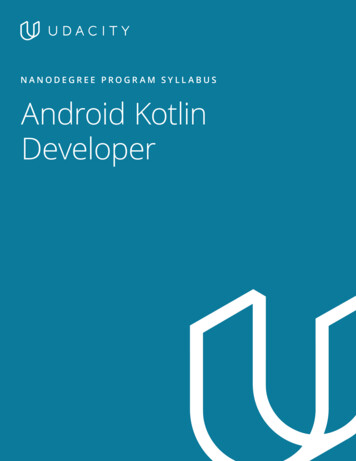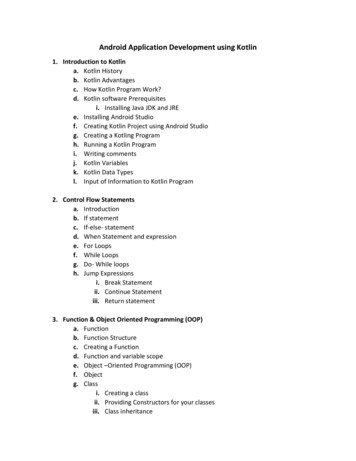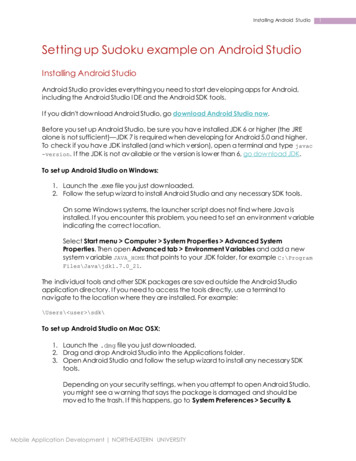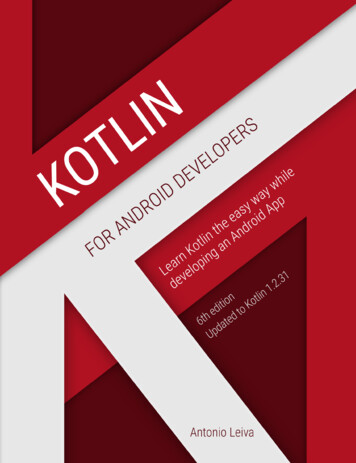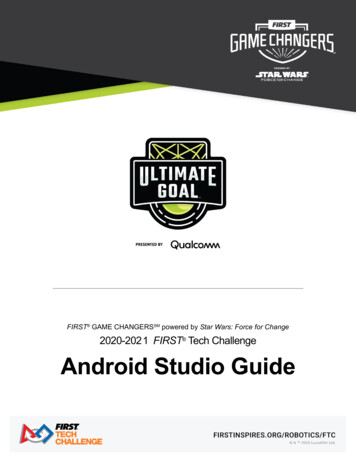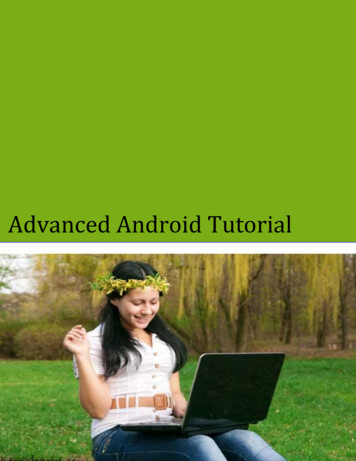
Transcription
Android Development with KotlinLearn Android application development with the extensive features ofKotlin
Marcin MoskalaIgor WojdaBIRMINGHAM - MUMBAI
Android Development with KotlinCopyright 2017 Packt PublishingAll rights reserved. No part of this book may be reproduced, stored in a retrievalsystem, or transmitted in any form or by any means, without the prior writtenpermission of the publisher, except in the case of brief quotations embedded incritical articles or reviews.Every effort has been made in the preparation of this book to ensure the accuracyof the information presented. However, the information contained in this book issold without warranty, either express or implied. Neither the authors, nor PacktPublishing, and its dealers and distributors will be held liable for any damagescaused or alleged to be caused directly or indirectly by this book.Packt Publishing has endeavored to provide trademark information about all ofthe companies and products mentioned in this book by the appropriate use ofcapitals. However, Packt Publishing cannot guarantee the accuracy of thisinformation.First published: August 2017Production reference: 1280817Published by Packt Publishing Ltd.Livery Place35 Livery StreetBirminghamB3 2PB, UK.
ISBN 978-1-78712-368-7www.packtpub.com
CreditsAuthorsCopy EditorMarcin MoskalaSafis EditingIgor WojdaReviewersProject CoordinatorMikhail GlukhikhVaidehi SawantStepan GoncharovCommissioning EditorProofreaderAaron LazarSafis Editing
Acquisition EditorIndexerChaitanya NairFrancy PuthiryContent Development EditorGraphicsRohit Kumar SinghAbhinash SahuTechnical EditorProduction CoordinatorPavan RamchandaniNilesh Mohite
About the AuthorsMarcin Moskala is an experienced Android developer who is always lookingfor ways to improve. He has been passionate about Kotlin since its early betarelease. He writes articles for Trade press and speaks at programmingconferences.Marcin is quite active in the programming and open source community and isalso passionate about cognitive and data science. You can visit his website (marcinmoskala.com), or follow him on GitHub (MarcinMoskala) and on Twitter(@marcinmoskala).I would like to thank my co-workers in Gamekit, Docplanner, and Apreel. Iespecially want to thank my supervisors, who were not only supportive, but whoare also constant source of knowledge and inspiration: Mateusz Mikulski,Krzyysztof Wolniak, Bartek Wilczynski and Rafal Trzeciak.I would like to thank Marek Kaminski, Gleb Smirnov, Jacek Jablonski, andMaciej Gorski for the corrections, and Dariusz Bacinski and James Shvarts forreviewing the code of example application.Also I would like to thank my family and my girlfriend, Maja Markiewicz for hersupport, help, making an environment that is supporting passion and selfrealization.Igor Wojda is an experienced engineer with over 11 years of experiencein software development. His adventure with Android started a few years ago,and he is currently working as a senior Android developer in the healthcareindustry. Igor has been deeply interested in Kotlin development long before the1.0 version was officially released, and he is an active member of the Kotlincommunity. He enjoys sharing his passion for coding with developers.To learn more about him, you can visit on Medium (@igorwojda) and follow him onTwitter (@igorwojda).
I would also like to thank amazing team at Babylon, who are not onlyprofessionals but also the inspiring and very helpful people, especially MikolajLeszczynski, Sakis Kaliakoudas, Simon Attard, Balachandar Kolathur Mani,Sergio Carabantes, Joao Alves, Tomas Navickas, Mario Sanoguera, SebastienRouif.I offer thanks to all the reviewers, especially technical reviewer StepanGoncharov, Mikhail Glukhikh and my colleagues who lived us feedback on thedrafts, especially Michał Jankowski.I also thankful to my family for all of their love and support. I'd like to thank myparents for allowing me to follow my ambitions throughout my childhood and forall the education.Thanks also go to JetBrains for creating this awesome language and to theKotlin community for sharing the knowledge, being helpful, open and inspiring.This book could not be written without you!I offer special thanks to my friends, especially Konrad Hamela, Marcin Sobolski,Maciej Gierasimiuk, Rafal Cupial, Michal Mazur and Edyta Skiba for theirfriendship, inspiration and continuous support. I value your advice immensely.
About the ReviewersMikhail Glukhikh has graduated from Ioffe Physical Technical School in 1995and from Saint Petersburg State Polytechnical University in 2001 with masterdegree in informational technologies. During 2001-2004, he was PhD student inthe same university, and then he defended PhD thesis in 2007. The title of histhesis is Synthesis method development of special-purpose informational andcontrol systems with structural redundancy.Mikhail worked in Kodeks Software Development Center during 1999-2000,and in Efremov Research Institute of Electrophysical Apparatus during 20012002. Since 2002, he is a lead developer in Digitek Labs at computer system andsoftware engineering department. He was a senior lecturer of the departmentfrom 2004 to 2007, from 2007 he is an associate professor. In 2013 he had oneyear stay in Clausthal University of Technology as an invited researcher. In2014, he worked at SPb office of Intel corporation, since March 2015, heparticipates in Kotlin language development at JetBrains company.Mikhail is one of Digitek Aegis defect detection tool authors, also he is one ofDigitek RA tool authors. Nowadays primary R&D areas include code analysis,code verification, code refactoring and code reliability estimation methods.Before he had also interests in fault-tolerant system design and analysis and alsoin high-productive digital signal processing complexes developing.Stepan Goncharov is currently working at Grab as the engineering lead of theDriver Android app. He is an organizer of Kotlin User Group Singapore who hasdeveloped apps and games for Android since 2008. He is a Kotlin and RxJavaaddict, and obsessed with elegant and functional style code. He is mainlyfocused on mobile apps architecture.Stepan is making a difference by spending more and more time contributing toopen-source projects. He is the reviewer of Learning RxJava, by Thomas Nield,
published by Packt.
www.PacktPub.comFor support files and downloads related to your book, please visit www.PacktPub.com.Did you know that Packt offers eBook versions of every book published, withPDF and ePub files available? You can upgrade to the eBook version at www.PacktPub.com and as a print book customer, you are entitled to a discount on the eBookcopy.Get in touch with us at service@packtpub.com for more details.At www.PacktPub.com, you can also read a collection of free technical articles, signup for a range of free newsletters and receive exclusive discounts and offers onPackt books and eBooks.https://www.packtpub.com/maptGet the most in-demand software skills with Mapt. Mapt gives you full access toall Packt books and video courses, as well as industry-leading tools to help youplan your personal development and advance your career.
Why subscribe?Fully searchable across every book published by PacktCopy and paste, print, and bookmark contentOn demand and accessible via a web browser
Customer FeedbackThanks for purchasing this Packt book. At Packt, quality is at the heart of oureditorial process. To help us improve, please leave us an honest review on thisbook's Amazon page at https://www.amazon.com/dp/1787123685.If you'd like to join our team of regular reviewers, you can e-mail us atcustomerreviews@packtpub.com. We award our regular reviewers with free eBooks andvideos in exchange for their valuable feedback. Help us be relentless inimproving our products!
Table of ContentsPrefaceWhat this book coversWhat you need for this bookWho this book is forConventionsReader feedbackCustomer supportDownloading the example codeErrataPiracyQuestions1.Beginning Your Kotlin AdventureSay hello to KotlinAwesome Kotlin examplesDealing with Kotlin codeKotlin PlaygroundAndroid StudioConfiguring Kotlin for the projectUsing Kotlin in a new Android projectJava to Kotlin converter (J2K)Alternative ways to run Kotlin codeKotlin under the hoodThe Kotlin standard libraryMore reasons to use KotlinSummary2.Laying a FoundationVariablesType inferenceStrict null safetySafe callElvis operatorNot null assertionLetNullability and JavaCastsSafe/unsafe cast operator
Smart castsType smart castsNon-nullable smart castPrimitive data typesNumbersCharArraysThe Boolean typeComposite data typesStringsString templatesRangesCollectionsStatements versus expressionsControl flowThe if statementThe when expressionLoopsThe for loopThe while loopOther iterationsBreak and continueExceptionsThe try. catch blockCompile-time constantsDelegatesSummary3.Playing with FunctionsBasic function declaration and usagesParametersReturning functionsVararg parameterSingle-expression functionsTail-recursive functionsDifferent ways of calling a functionDefault arguments valuesNamed arguments syntaxTop-level functionsTop-level functions under the hood
Local functionsNothing return typeSummary4.Classes and ObjectsClassesClass declarationPropertiesRead-write versus read-only propertyProperty access syntax between Kotlin and JavaIncrement and decrement operatorsCustom getters/settersThe getter versus property default valueLate-initialized propertiesAnnotating propertiesInline propertiesConstructorsProperty versus constructor parameterConstructor with default argumentsPatternsInheritanceThe JvmOverloads annotationInterfacesData classesThe equals and hashCode methodThe toString methodThe copy methodDestructive declarationsOperator overloadingObject declarationObject expressionCompanion objectsCompanion object instantiationEnum classesInfix calls for named methodsVisibility modifiersInternal modifier and Java bytecodeSealed classesNested classesImport aliasesSummary
5.Functions as First-Class CitizensFunction typeWhat is function type under the hood?Anonymous functionsLambda expressionsImplicit name of a single parameterHigher-order functionsProviding operations to functionsObserver (Listener) patternCallback after a threaded operationCombination of named arguments and lambda expressionsLast lambda in argument conventionNamed code surroundingProcessing data structures using LINQ styleJava SAM support in KotlinNamed Kotlin function typesNamed parameters in function typeType aliasUnderscore for unused variablesDestructuring in lambda expressionsInline functionsThe noinline modifierNon-local returnsLabeled return in lambda expressionsCrossinline modifierInline propertiesFunction ReferencesSummary6.Generics Are Your FriendsGenericsThe need for genericsType parameters versus type argumentsGeneric constraintsNullabilityVarianceVariance modifiersUse-site variance versus declaration-site varianceCollection varianceVariance producer/consumer limitationInvariant constructor
Type erasureReified type parametersThe startActivity methodStar-projectionsType parameter naming conventionsSummary7.Extension Functions and PropertiesExtension functionsExtension functions under the hoodNo method overridingAccess to receiver elementsExtensions are resolved staticallyCompanion object extensionsOperator overloading using extension functionsWhere should top-level extension functions be used?Extension propertiesWhere should extension properties be used?Member extension functions and propertiesType of receiversMember extension functions and properties under the hoodGeneric extension functionsCollection processingKotlin collection type hierarchyThe map, filter, flatMap functionsThe forEach and onEach functionsThe withIndex and indexed variantsThe sum, count, min, max, and sorted functionsOther stream processing functionsExamples of stream collection processingSequenceFunction literals with receiverKotlin standard library functionsThe let functionUsing the apply function for initializationThe also functionThe run and with functionThe to functionDomain-specific languageAnkoSummary
8.DelegatesClass delegationDelegation patternDecorator patternProperty delegationWhat are delegated properties?Predefined delegatesThe lazy functionThe notNull functionThe observable delegateThe vetoable delegateProperty delegation to Map typeCustom delegatesView bingingPreference bindingProviding a delegateSummary9.Making Your Marvel Gallery ApplicationMarvel GalleryHow to use this chapterMake an empty projectCharacter galleryView implementationNetwork definitionBusiness logic implementationPutting it all togetherCharacter searchCharacter profile displaySummary
PrefaceNowadays, the Android application development process is quite extensive.Over the last few years, we have seen how various tools have evolved to makeour lives easier. However, one core element of Android application developmentprocess hasn’t changed much over time, Java. The Android platform adapts tonewer versions of Java, but to be able to use them, we need to wait for a verylong time until new Android devices reach proper market propagation. Also,developing applications in Java comes with its own set of challenges since Javais an old language with many design issues that can’t be simply resolved due tobackward compatibility constraints.Kotlin, on the other hand, is a new but stable language that can run on allAndroid devices and solve many issues that Java cannot. It brings lots of provenprogramming concepts to the Android development table. It is a great languagethat makes a developer's life much easier and allows to produce more secure,expressive, and concise code.This book is an easy-to-follow, practical guide that will help you to speed up andimprove the Android development process using Kotlin. We will present manyshortcuts and improvements over Java and new ways of solving commonproblems. By the end of this book, you will be familiar with Kotlin features andtools, and you will be able to develop an Android application entirely in Kotlin.
What this book coversBeginning Your Kotlin Adventure, discusses Kotlin language, its featuresand reasons to use it. We'll introduce reader to the Kotlin platform and show howKotlin fits into Android development process.Chapter 1,Laying a Foundation, is largely devoted to the building blocks of theKotlin. It presents various constructs, data types, and features that make Kotlinan enjoyable language to work with.Chapter 2,Playing with Functions, explains various ways to define and call afunction. We will also discuss function modifiers and look at possible locationswhere function can be defined.Chapter 3,Chapter 4,Classes and Objects, discusses the Kotlin features related to objectoriented programming. You will learn about different types of class. We will alsosee features that improve readability: properties operator overloading and infixcalls.Chapter 5,Functions as First-Class Citizens, covers Kotlin support for functionalprogramming and functions as first-class citizens. We will take a closer look atlambdas, higher order functions, and function types.Chapter 6,Generics Are Your Friends, explores the subjects of generic classes,interfaces, and functions. We will take a closer look at the Kotlin generic typesystem.Chapter 7,Extension Functions and Properties, demonstrates how to add newbehavior to an existing class without using inheritance. We will also discusssimpler ways to deal with collections and stream processing.Chapter 8,Delegates, shows how Kotlin simplifies class delegation due to built-inlanguage support. We will see how to use it both by using built-in propertydelegates and by defining custom ones.Chapter 9,Making Your Marvel Gallery Application, utilizes most of the features
discussed in the book and use it to build a fully functional Android application inKotlin.
What you need for this bookTo test and use the code presented in this book, you need only Android Studioinstalled. Chapter 1, Beginning your Kotlin Adventure, explains how a new projectcan be started and how the examples presented here can be checked. It alsodescribes how most of the code presented here can be tested without anyprogram installed.
Who this book is forTo use this book, you should to be familiar with two areas:You need to know Java and object-oriented programming concepts,including objects, classes, constructors, interfaces, methods, getters, setters,and generic types. So, if this area does not ring a bell, it will be difficult tofully understand the rest of this book. Start instead with an introductoryJava book and return to this book afterward.Though not mandatory, understanding the Android platform is muchdesirable because it will help you to understand the presented examples inmore detail, and you’ll have deeper understanding the problems that aresolved by Kotlin. If you are an Android developer with 6-12 months ofexperience or you have created few Android applications, you’ll be fine. Onthe other hand, if you feel comfortable with OOP concepts but yourknowledge of Android platform is limited, you will probably still be OK formost of the book.Being open-minded and eager to learn new technologies will be very helpful. Ifsomething makes you curious or catches your attention, feel free to test it andplay with it while you are reading this book
ConventionsIn this book, you will find a number of text styles that distinguish betweendifferent kinds of information. Here are some examples of these styles and anexplanation of their meaning.Code words in text, database table names, folder names, filenames, fileextensions, pathnames, dummy URLs, user input, and Twitter handles are shownas follows: "Let's look at the range data type, which allows to define endinclusive ranges."A block of code is set as follows:val capitol "England" to "London"println(capitol.first) // Prints: Englandprintln(capitol.second) // Prints: LondonWhen we wish to draw your attention to a particular part of a code block, therelevant lines or items are set in bold:ext.kotlin version '1.1.3'repositories {maven { url 'https://maven.google.com' }jcenter()}Any command-line input or output is written as follows:sdk install kotlinNew terms and important words are shown in bold. Words that you see on thescreen, for example, in menus or dialog boxes, appear in the text like this: "Setname, package, and location for the new project. Remember to tick IncludeKotlin support option."Warnings or important notes appear like this.Tips and tricks appear like this.
Reader feedbackFeedback from our readers is always welcome. Let us know what you thinkabout this book-what you liked or disliked. Reader feedback is important for usas it helps us develop titles that you will really get the most out of.To send us general feedback, simply e-mail feedback@packtpub.com, and mention thebook's title in the subject of your message.If there is a topic that you have expertise in and you are interested in eitherwriting or contributing to a book, see our author guide at www.packtpub.com/authors.
Customer supportNow that you are the proud owner of a Packt book, we have a number of thingsto help you to get the most from your purchase.
Downloading the example codeYou can download the example code files for this book from your account at http://www.packtpub.com. If you purchased this book elsewhere, you can visit http://www.packtpub.com/support and register to have the files e-mailed directly to you. You candownload the code files by following these steps:1.2.3.4.5.6.7.Log in or register to our website using your e-mail address and password.Hover the mouse pointer on the SUPPORT tab at the top.Click on Code Downloads & Errata.Enter the name of the book in the Search box.Select the book for which you're looking to download the code files.Choose from the drop-down menu where you purchased this book from.Click on Code Download.Once the file is downloaded, please make sure that you unzip or extract thefolder using the latest version of:WinRAR / 7-Zip for WindowsZipeg / iZip / UnRarX for Mac7-Zip / PeaZip for LinuxThe code bundle for the book is also hosted on GitHub at ment-with-Kotlin. We also have other code bundles from our richcatalog of books and videos available at https://github.com/PacktPublishing/. Check themout!
ErrataAlthough we have taken every care to ensure the accuracy of our content,mistakes do happen. If you find a mistake in one of our books-maybe a mistakein the text or the code-we would be grateful if you could report this to us. Bydoing so, you can save other readers from frustration and help us improvesubsequent versions of this book. If you find any errata, please report them byvisiting http://www.packtpub.com/submit-errata, selecting your book, clicking on theErrata Submission Form link, and entering the details of your errata. Once yourerrata are verified, your submission will be accepted and the errata will beuploaded to our website or added to any list of existing errata under the Erratasection of that title.To view the previously submitted errata, go to https://www.packtpub.com/books/content/support and enter the name of the book in the search field. The required informationwill appear under the Errata section.
PiracyPiracy of copyrighted material on the Internet is an ongoing problem across allmedia. At Packt, we take the protection of our copyright and licenses veryseriously. If you come across any illegal copies of our works in any form on theInternet, please provide us with the location address or website nameimmediately so that we can pursue a remedy.Please contact us at copyright@packtpub.com with a link to the suspected piratedmaterial.We appreciate your help in protecting our authors and our ability to bring youvaluable content.
QuestionsIf you have a problem with any aspect of this book, you can contact usat questions@packtpub.com, and we will do our best to address the problem.
Beginning Your Kotlin AdventureKotlin is great language that makes Android development easier, faster, andmuch more pleasant. In this chapter, we will discuss what Kotlin really is andlook at many Kotlin examples that will help us build even better Androidapplications. Welcome to the amazing journey of Kotlin, that will change theway you think about writing code and solving common programming problems.In this chapter, we will cover the following topics:First steps with KotlinPractical Kotlin examplesCreating new Kotlin project in Android StudioMigrating existing Java project to KotlinThe Kotlin standard library (stdlib)Why Kotlin is a good choice to learn
Say hello to KotlinKotlin is a modern, statically typed, Android-compatible language that fixesmany Java problems, such as null pointer exceptions or excessive codeverbosity. Kotlin is a language inspired by Swift, Scala, Groovy, C#, and manyother languages. Kotlin was designed by JetBrains professionals, based onanalysis of both developers experiences, best usage guidelines (most importantare clean code and effective Java), and data about this language's usage. Deepanalysis of other programming languages has been done. Kotlin tries hard to notrepeat the mistakes from other languages and take advantage of their most usefulfeatures. When working with Kotlin, we can really feel that this is a mature andwell-designed language.Kotlin takes application development to a whole new level by improving codequality and safety and boosting developer performance. Official Kotlin supportfor the Android platform was announced by Google in 2017, but the Kotlinlanguage has been here for some time. It has a very active community and Kotlinadoption on the Android platform is already growing quickly. We can describeKotlin as a safe, expressive, concise, versatile, and tool-friendly language thathas great interoperability with Java and JavaScript. Let's discuss these features:Safety: Kotlin offers safety features in terms of nullability andimmutability. Kotlin is statically typed, so the type of every expression isknown at compile time. The compiler can verify that whatever property ormethod that we are trying to access or a particular class instance actuallyexists. This should be familiar from Java which is also statically typed, butunlike Java, Kotlin type system is much more strict (safe). We have toexplicitly tell the compiler whether the given variable can store null values.This allows making the program fail at compile time instead of throwing aNullPointerException at runtime:
Easy debugging: Bugs can be detected much faster during the developmentphase instead of crashing the application after it is released and thusdamaging the user experience. Kotlin offers a convenient way to work withimmutable data. For example, it can distinguish mutable (read-write) andimmutable (read-only) collections by providing convenient interfaces(under the hood collections are still mutable).Conciseness: Most of the Java verbosity was eliminated. We need less codeto achieve common tasks and thus the amount of boilerplate code is greatlyreduced, even comparing Kotlin to Java 8. As a result, the code is alsoeasier to read and understand (expressive).Interoperability: Kotlin is designed to seamlessly work side by side withJava (cross-language project). The existing ecosystem of Java libraries andframeworks works with Kotlin without any performance penalties. ManyJava libraries have even Kotlin-specific versions that allow more idiomaticusage with Kotlin. Kotlin classes can also be directly instantiated andtransparently referenced from Java code without any special semantics andvice versa. This allows us to incorporate Kotlin into existing Androidprojects and use Kotlin easily together with Java (if we want to).Versatility: We can target many platforms, including mobile applications(Android), server-side applications (backend), desktop applications,frontend code running in the browser, and even build systems (Gradle).Any programming language is only as good as its tool support. Kotlin hasoutstanding support for modern IDEs such as Android Studio, IntelliJ Idea, andEclipse. Common tasks like code assistance or refactoring are handled properly.The Kotlin team works hard to make the Kotlin plugin better with every singlerelease. Most of the bugs are quickly fixed and many of the features requestedby the community are implemented.Kotlin bug tracker: https://youtrack.jetbrains.com/issues/KTKotlin slack channel: http://slack.kotlinlang.org/Android application development becomes much more efficient and pleasantwith Kotlin. Kotlin is compatible with JDK 6, so applications created in Kotlinrun safely even on old Android devices that precede Android 4.Kotlin aims to bring you the best of both worlds by combining concepts and
elements from both procedural and functional programming. It follows manyguidelines are described in the book, Effective Java, 2nd Edition, by JoshuaBloch which is considered must read a book for every Java developer.On top of that, Kotlin is open sourced, so we can check out the project and beactively involved in any aspect of the Kotlin project such as Kotlin plugins,compilers, documentations or Kotlin language itself.
Awesome Kotlin examplesKotlin is really easy to learn for Android developers because the syntax issimilar to Java and Kotlin often feels like natural Java evolution. At thebeginning, a developer usually writes Kotlin code having in mind habits fromJava, but after a while, it is very easy to move to more idiomatic Kotlinsolutions. Let's look at some cool Kotlin features, and see where Kotlin mayprovide benefits by solving common programming tasks in an easier, moreconcise, and more flexible way. We have tried to keep examples simple and selfexplanatory, but they utilize content from various parts of this book, so it's fine ifthey are not fully understood at this point. The goal of this section is to focus onthe possibilities and present what can be achieved by using Kotlin. This sectiondoes not necessarily need to fully describe how to achieve it. Let's start witha variable declaration:var name "Igor" // Inferred type is Stringname "Marcin"Notice that Kotlin does not require semicolons. You can still use them, but theyare optional. We also don't need to specify a variable type because it's inferredfrom the context. Each time the compiler can figure out the typefrom the context we don't have to explicitly specify it. Kotlin is a strongly typedlanguage, so each variable has an adequate type:var name "Igor"name 2 // Error, because name type is StringThe variable has an inferred String type, so assigning a different value (integer)will result in compilation error. Now, let's see how Kotlin improves the way toadd multiple strings using string templates:val name "Marcin"println("My name is name") // Prints: My name is MarcinWe need no more joining strings using the character. In Kotlin, we can easilyincorporate single variable or even whole expression into string literals:val name "Igor"println("My name is {name.toUpperCase()}")// Prints: My name is IGOR
In Java any variable can store null values. In Kotlin strict null safety forces us toexplicitly mark each variable that can store nullable values:var a: String "abc"a null // compilation errorvar b: String? "abc"b null // It is correctAdding a question mark to a data type (string versus string?), we say thatvariable can be nullable (can store null references). If we don't mark variable asnullable, we will not be able to assign a nullable reference to it. Kotlin alsoallows to deal with nullable variables in proper ways. We can use safe calloperator to safely call methods on potentially nullable variables:savedInstanceState?.doSomethingThe method doSomething will be invoke
Driver Android app. He is an organizer of Kotlin User Group Singapore who has developed apps and games for Android since 2008. He is a Kotlin and RxJava addict, and obsessed with elegant and functional style code. He is mainly focused on mobile apps architecture. Stepan is making a
